#Ice Maiden of Ampato
Explore tagged Tumblr posts
Text
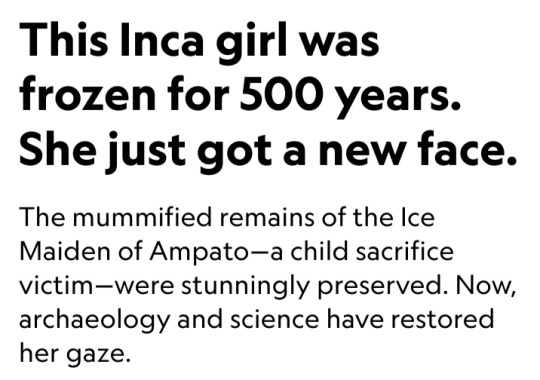

By Erin Blakemore
October 25, 2023
More than 500 years ago, a 14-year-old girl was escorted up an Andean peak and sacrificed to Inca gods.
Buried on the mountain with a variety of offerings, the young woman’s body naturally mummified over time, preserving her hair, her fingernails, the colorful robes she wore on her last day.
But at some point across the centuries, her face became exposed to the elements, her features slowly vanishing over seasons of sunlight and snowfall.
Now, that long-lost face has been recovered thanks to painstaking archaeological analysis and forensic reconstruction.
A striking 3-D bust of the young woman, known today as the Ice Maiden of Ampato, is the centerpiece of a new exhibit in Peru and part of an ongoing effort to understand the drama of human sacrifice practiced in the Andes half a millennium ago.
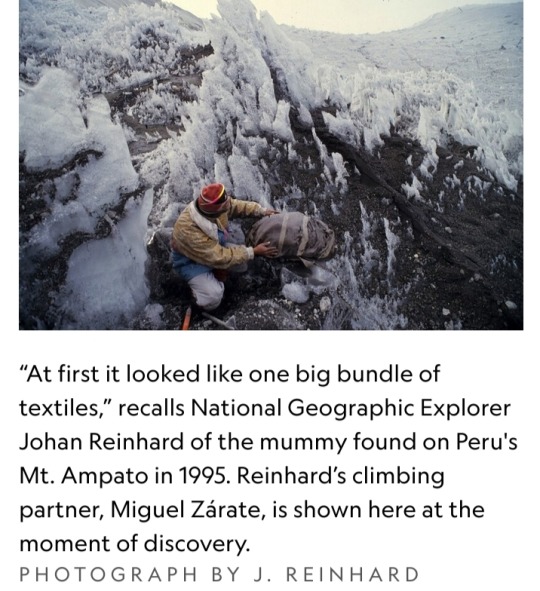
A sacrificial offering
When National Geographic Explorer Johan Reinhard encountered the mummy, also known as Juanita, atop 21,000-foot Mount Ampato during a 1995 expedition, he knew he had discovered something spectacular.
“At first it looked like one big bundle of textiles,” Reinhard recalls. Then he saw the wizened face amid the folds of fabric.
Here was a young victim of the elusive Inca ritual known as capacocha.
Capacocha mostly involved the sacrifice of children and animals who were offered to the gods in response to natural disasters — to consolidate state power in far-flung provinces of the Inca Empire, or simply to please the deities.
The ritual played an important part in sustaining the Inca Empire. It would involve feasts and grand processions to accompany the children, who appear to have been chosen for their beauty and physical perfection.
Being selected for sacrifice, researchers believe, would have considered a deep honor by the child’s family and community.
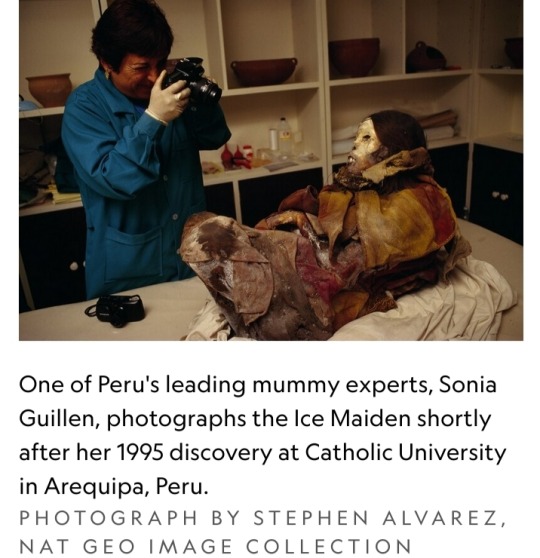
Most of the information we have on capacocha, however, is second hand, notes Dagmara Socha, an archaeologist with the Center for Andean Studies at the University of Warsaw who studies the ritual and commissioned the facial reconstruction of the Ice Maiden of Ampato.
“No European colonist ever saw the ceremony,” she explains.
Despite gaps in the historical record, the high-altitude archaeological finds of more than a dozen Inca children on Ampato and other mountains point provide critical evidence for what happened during these rituals.
The means of sacrifice varied, perhaps due to customs related to specific gods. Some children were buried alive or strangled; others had their hearts removed.
The Ice Maiden’s life ended with a single blunt-force blow to the back of the skull.
In search of the Ice Maiden
Oscar Nilsson knows that skull intimately: He spent months with a replica of it in his Stockholm studio, eventually fashioning a sculpture of the 14-old-girl that, glimpsed from afar, almost seems alive.
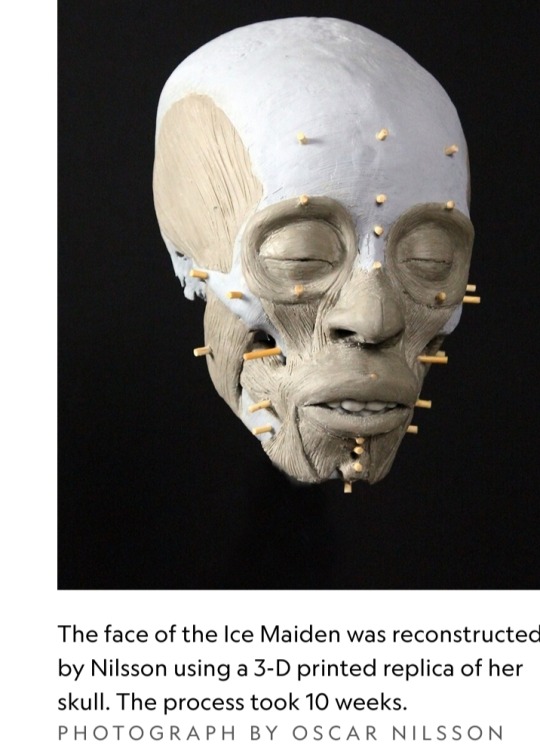
It’s a two-step process, says the Swedish archaeologist and sculptor.
First, Nilsson immerses himself in the world of his subject with an archaeologist’s eye for detail, digesting as much data as possible to understand what she might have looked like.
Even without a mummified face, he can extrapolate the likely depth of the facial tissue that once draped over those bones, using everything from CT scans to DNA analyses to information about diet and disease to make educated guesses about the individual’s face.
Then came the handiwork. Nilsson printed a 3-D replica of the Ice Maiden’s skull, plugging wooden pegs into its surface to guide the depth and placement of each hand-crafted, plasticine clay muscle.
Eerie eyes, masseter muscles, a nose, the delicate rope-like tissues that constitute a human face: each was added in turn.
After making a silicone mold of the bust, he added hundreds of individual hairs and pores in shades of brown and pink.
It took ten weeks.
Following the Inca Gods
The result, wrapped in robes woven by local women from Peru's Centro de Textiles Tradicionales, is the main attraction at “Capacocha: Following the Inca Gods” at the Museo Santuarios Andinos in Arequipa, Peru through November 18.
The reconstruction will be displayed alongside the Ice Maiden’s mummy, accompanied by the stories of 15 other children selected for capacocha atop Ampato and other Andean peaks.
Their ages range from 3 to about 13. The mummies and skeletal remains of several are featured as 3-D models at the exhibition, which also showcases holographs of some of the sacred items buried alongside them.
These natural mummies offer scientists tantalizing clues about their last days.
When Socha and colleagues conducted toxicological and forensic analyses of the remains of a toddler and four six-to-seven-year-old victims featured in the exhibition, they found they were well cared for in the months before their sacrifice.
They were fed a steady diet of coca leaves, ayahuasca vine, and alcohol in the weeks before their deaths — not as much to intoxicate them as to keep them sedated and anxiety-free as the timeline hurtled toward their sacrifice.
“We were really surprised by the toxicology results,” says Socha.
“It wasn’t only a brutal sacrifice. The Inca also wanted the children to be in a good mood. It was important to them that they go happily to the gods.”
High altitude, psychogenic substances, the spectacular view, the knowledge the afterlife was near — all must have made for an astonishing ceremony, says Reinhard.
“The whole phenomenon must have been overpowering.”
During the last phase of his reconstruction, Nilsson spent hours contemplating and attempting to capture the young girl’s presence 500 years after her death.
The result is both unsettlingly realistic and jarringly personal.
“She was an individual,” the forensic reconstructionist says.
“She must have understood her life would end on the mountaintop in a couple of weeks. We can only hope that she believed in the afterworld herself.”
For Reinhard, finally seeing the face of the girl he carried down the mountain on his back decades ago brought the Ice Maiden’s story full circle.
“It brings her back to life,” he says. The reconstruction brings the focus as much to her culture and daily life as to her spectacular death.
But Nilsson never forgot the way the Ice Maiden died, even as he brought her to life through his reconstruction.
More than anything, he says, he wanted to capture a sense of being frozen — a nod not just to her icy, mummified future but to a girl teetering on the edge of eternity, though still very much alive.
“She knew she was supposed to smile, to express pride,” he says. “Proud to be chosen. But still very, very afraid.”
#Ice Maiden of Ampato#Inca Girl#archaeological analysis#forensic reconstruction#human sacrifice#Peru#3-D bust#Juanita#Johan Reinhard#Mount Ampato#National Geographic#National Geographic Explorer#expedition#1990s#20th century#capacocha#Inca ritual#Inca Empire#Dagmara Socha#facial reconstruction#archaeology#archaeologists#Oscar Nilsson#sculptor#Centro de Textiles Tradicionales#Capacocha: Following the Inca Gods#Museo Santuarios Andinos#natural mummies#culture#forensic reconstructionist
2 notes
·
View notes
Text

0 notes
Text
The silicone-made bust portrays a young woman with pronounced cheekbones, black eyes and tanned skin. Produced by a team of Polish and Peruvian scientists who worked with a Swedish sculptor specializing in facial reconstructions, it was presented in a ceremony at the Andean Sanctuaries Museum of the Catholic University of Santa Maria in Arequipa. "I thought I'd never know what her face looked like when she was alive," said Johan Reinhard, the U.S. anthropologist who found the mummy known as "Juanita" and the "Inca Ice Maiden." Reinhard discovered the mummy in 1995 at an altitude of more than 6,000 meters (19,685 feet) on the snow-capped Ampato volcano. "Now 28 years later, this has become a reality thanks to Oscar Nilsson's reconstruction," he said.
Continue Reading
74 notes
·
View notes
Text
Juanita Reconstruction Illustrates Importance of Bioarcheology

A November 2023 CNN article said scientists have reconstructed a teenage Incan girl who lived 500 years ago. Discovered in 1995 in ice, the girl had been sacrificed and buried near the dormant volcano at the Ampato summit in Peru. This discovery illustrates the wonder of bioarchaeology, which contributed to bringing the century-old story to life.
Bioarchaeology is a branch of archaeology that studies bones and biological materials found around human remains. Scientists can use the bones to gather information about how people lived.
Bioarchaeology has played a critical role in reconstructing histories, including that of the Incas, who lived in Peru and Chile for more than 300 years. Their known history began in around 1,200 and ended in 1533, but historians cite the defeat of the Chanca in 1438 as the onset of the rise of the Incan Empire. The Incas went on to organize institutions and build an extensive network of roads connecting towns and villages.
The Incan culture included sacrificial ceremonies to appease the gods and protect the community from natural disasters such as volcanic eruptions and earthquakes. The Incas sacrificed young women and children because of their purity and beauty.
Researchers believe that Juanita died as a sacrifice because of her ceremonial clothing. The teen's burial site also contained ceramic objects, gold and silver female figures, woven bags, pottery, and llama bones. The ceramic objects featured geometric shapes, which researchers believe may have been a part of the Incan communication system.
In 2018, 23 years after the discovery of Juanitain the Peruvian mountains, Dr. Dagmara Socha, a bioarcheologist at the Center for Andean Studies at the University of Warsaw in Cusco, Peru, began investigating Juanita and other remains and objects found at the Ampato, Pichu Pichu, and Misti volcanoes. They discovered that children and women chewed coca leaves and drank ayahuasca during the weeks leading up to their sacrifice. This finding suggests that the hallucinogenic and psychotropic drugs lessened their anxiety before the sacrifice, a fact consistent with Juanita’s ingestion of alcohol and coca before her sacrifice.
Further, after analyzing Juanita’s hair samples, researchers learned that she may have come from an elite family since her diet included meat. Juanita was between 13 and 15 when she died after being struck on the head, according to CT scans.
In March 2022, Swedish artist Oscar Nilsson used CT scans of Juanita to build a 3D model of her skull, which guided in reconstructing her face and body. The artist drew his reconstruction from tomography scans and information on her age and complexion. He relied on tissue depth markers based on skull measurements to understand her facial proportions. The reconstruction of Juanita took 400 hours, and her face alone took six months. Nilsson was methodical in his reconstruction, relying on forensic techniques to make the teen appear realistic. This reconstruction puts a face to the history of the teen and her people, which may not have been possible without bioarchaeology. Researchers and scientists have given Juanita the nicknames "Ice Maiden," since she was discovered in ice, and “the Lady of Ampato.”
1 note
·
View note
Text
1 note
·
View note
Text
1 note
·
View note
Text
This Inca girl was frozen for 500 years. She just got a new face.
The mummified remains of the Ice Maiden of Ampato—a child sacrifice victim—were stunningly preserved. Now, archaeology and science have restored her gaze. — Read on www.nationalgeographic.com/premium/article/ice-maiden-ampato-inca-mummy-facial-reconstruction
View On WordPress
0 notes
Text
Momia Juanita: the Ampato Ice Maiden
The greatest part about the dead is their incredible ability to tell a story. From a skeleton one is able to gather information about an individual’s lifestyle, where they lived, what they may have looked like in life, among other aspects. When one has a mummy, however, a near-complete remnant of that individual’s time can be studied. Mummies offer a unique glimpse into past cultures and their burial practices, being frozen in time, so to speak. This rings true especially in the case of ice mummies, just some of the best preserved examples of corpses on the planet. Today’s focus is on the Ampato Ice Maiden, known also as Momia Juanita.
Who is she? Juanita is the mummy of a 14 year old girl who was buried on the summit of Mount Ampato in southern Peru, part of the Andes mountain range. She’s believed to have died between the years 1440-1480 BCE, placing her death around the time of the first Spanish contact with the Inca Empire. Whether Juanita came from a noble or common family is inconclusive, however it is known via isotope analysis that at least 6 months prior to her death she lived in the capital of Cusco. Interestingly, her mitochondrial DNA cannot be found in any current databases, though she most certainly was a Native Inca with ancestral ties to the western Pacific. Juanita is a mummy of significance because she was an Inca child sacrifice. (Content Warning for mummies under the cut)
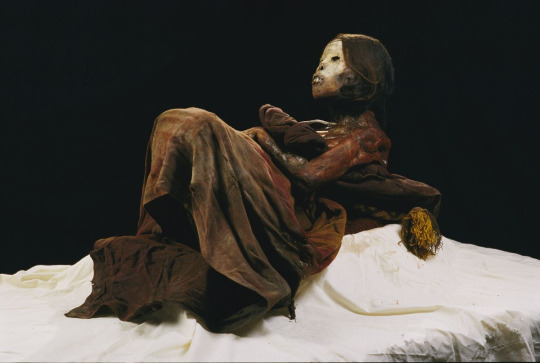
Capacocha A key part of life in the Inca Empire was human sacrifice, or “Capacocha.” These sacrifices corresponded with calendar events, royal births and deaths, military victories, et cetera, and were performed in order to prevent a natural disaster. Usually, a child would be sacrificed to Inca gods in a sacred location depending on what it was they wished to prevent. The timeframe of Juanita’s death happened to correspond with the eruptions of two major volcanoes in her region, which threatened precipitation. Perhaps, then, Juanita was sacrificed to ensure rainfall.
How did she die? The process of Capacocha is lengthy and arduous, taking months to complete. A child could travel great distances across the Empire until they came to their final resting place. In Juanita’s case, she would have been paraded through Cusco with villagers of all ages in attendance until the massive party reached the base camp at Mount Ampato, approximately 16,300 feet above sea level. The subject of the children being heavily drugged with coca and alcohol on their trek is a fact, this could have taken place regularly for 6 to 8 weeks before sacrifice, but it is unknown whether Juanita was under the influence during the first leg of her journey. When she and her party, now considerably smaller, reached the summit of Mount Ampato, she certainly would have been placed into a stupor before the fatal blow to her skull was delivered. None can speak of what was going through Juanita’s mind at the time, but it was found she was clutching her ceremonial dress in a death grip over 500 years later.
The burial Juanita was discovered in 1995 by Johann Reinhard and Miguel Zarate near the summit of Mount Ampato- she had recently tumbled a way down the mountain after a volcanic eruption. Her burial site was at the very peak, in it were pottery and textiles, some of which were much larger than Juanita herself. Her clothes were rich in colour with intricate patterns, she wore leather slippers, a ceremonial shawl and dress, possibly even a headdress made of macaw feathers though it is uncertain if it fell off in her fall or if she was not buried in one. She was discovered wrapped in a bundle.
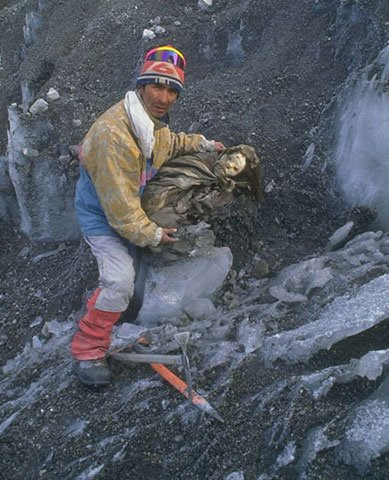
(Miguel Zarate meeting Juanita for the first time)
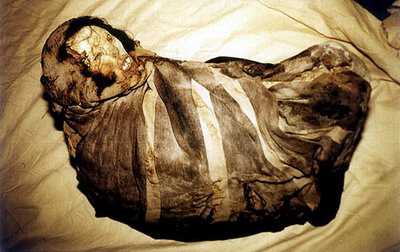
The body Her mummy was completely frozen and perfectly preserved, save for her face which had leathered in the sun following the recent volcanic eruption and her brain, dried from exposure. Her skin was intact, as were her muscles and even her fingernails. In total, she weighed about 90lbs and was considerably small- though her size, even after mummification, was not uncommon during her time.
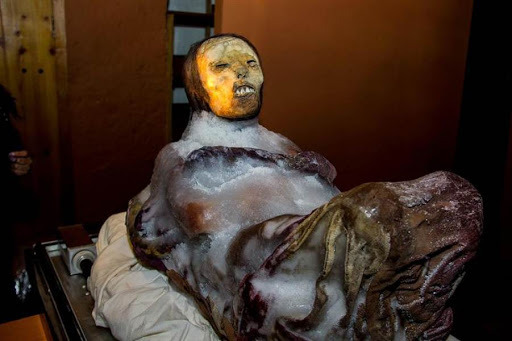
The discovery of an ice mummy is the dream of many an anthropologist, a real frozen human being from ages ago is quite possibly at the very top of coolest things to ever stumble upon. Juanita is so fascinating because she offers insight into the sacrificial practices of the Inca Empire. It is a privilege to study such an immaculately-preserved body, perhaps in the future there may be more discoveries to be made with regard to her mummy and other Inca sacrifices of Mount Ampato.
37 notes
·
View notes
Photo

Momia Juanita, also referred to as the Inca Ice Maiden, is a well-preserved frozen body of a young girl believed to be between 11-years-old and 15-years-old. She was murdered as an offering to the Inca gods at some point between 1450 and 1480. She was discovered in 1995 on Mount Ampato in Peru.
865 notes
·
View notes
Text
Xác ướp 500 tuổi nguyên vẹn như 'mới qua đời'
New Post has been published on https://khachsanthanhdong.com/xac-uop-500-tuoi-nguyen-ven-nhu-moi-qua-doi.html
Xác ướp 500 tuổi nguyên vẹn như 'mới qua đời'

PeruMái tóc đen dày, làn da được bảo quản tới từng sợi lông tơ khiến Juanita được coi là xác ướp Inca nguyên vẹn nhất từng được phát hiện.
Năm 1992, nhà leo núi Peru Miguel Zárate dẫn một đoàn thám hiểm núi Ampato (6.288 m) thì tìm thấy những mảnh gỗ kỳ lạ trên đỉnh núi băng giá. Ông nghi ngờ đây có thể là một điểm khảo cổ.
Tới tháng 9/1995, Zárate thuyết phục nhà khảo cổ Mỹ Johan Reinhard leo núi Ampato, sau vụ phun trào của núi lửa Sabancaya gần đó. Trận phun trào lớn tới mức làm tan tuyết trên đỉnh Ampato và phơi bày những kín bị chôn vùi hàng trăm năm trước.
Zárate sớm tìm thấy một bức tượng và vài lễ vật khác, nhưng nơi có thể là hố chôn cất đã sập và không còn dấu hiệu của một thi hài nào. Đội thám hiểm phải lăn những tảng đá xuống sườn núi để tìm kiếm, lúc này Zárate đi theo và phát sinh ra xác ướp của một cô gái người Inca. Xét từ vị trí xa xôi của ngôi mộ và những lễ vật xung quanh, các nhà khoa học cho rằng thiếu nữ khoảng 12 tới 14 tuổi này đã được hiến tế cho các vị thần trên đỉnh núi.
“Những bác bỏ sĩ sửng sốt và nói rằng xác ướp này không giống 500 tuổi, nhưng trông như thể mới qua đời vài tuần trước”, nhà khảo cổ Reinhard nói trong một cuộc ph���ng vấn năm 1999.Phải mất vài ngày, đoàn thám hiểm mới có thể đưa xác ướp đóng băng xuống làng Cabanaconde. Từ đây, thi hài được đưa vào một chiếc tủ đông lạnh riêng của nhà leo núi Zárate, tới Đại học Católica ở TP Arequipa để trải qua một cuộc kiểm tra.
Không khí loãng và cái lạnh trên đỉnh núi đã bảo quản cái xác nguyên vẹn tới mức mái tóc còn đen dày, làn da trên đôi bàn tay lộ ra từng sợi lông tơ thấy rõ bằng mắt thường. Người ta đặt tên cho xác ướp là Juanita – The Ice Maiden (Thiếu nữ băng giá Juanita).
Cuộc đời ngắn ngủi của Juanita kết thúc trong một lễ hiến tế – điều không hề thất thường trong văn hoá Inca. Song những ngày trước khi cô qua đời rất khác so với cuộc sống của một cô gái Inca chung. Các nhà khoa học đã phân tích DNA từ mái tóc của Juanita, để tìm ra cơ chế ăn uống của cô trước lễ hiến tế.
Dấu vết trên tóc cho thấy Juanita đã được chọn làm người hy sinh khoảng một năm trước khi chết. Cô chuyển từ cơ chế ăn vốn ch�� có khoai tây và rau quả, sang những thực phẩm cao cấp hơn như protein động vật, một lượng lớn lá coca và rượu.
Andrew Wilson, một chuyên gia pháp y và khảo cổ học, giảng giải với National Geographic, rằng khoảng 6 – 8 tuần sau rốt trong cuộc đời những đứa trẻ hiến tế là cơn say triền miên từ lá coca và rượu chicha. phối hợp với điều kiện tự nhiên trên núi cao, thân thể chúng chìm vào giấc nghìn thu. Nhưng Juanita rủi ro mắn như vậy. bác bỏ sĩ X quang quẻ Elliot Fishman phát sinh ra Juanita bị tiến công một cú chí mạng vào đầu. Sau khi bị tiến công chết, hộp sọ của cô bị tụ máu, đẩy bộ não lệch sang một bên.
Một xác ướp được bảo quản nguyên vẹn như Juanita ngay tức khắc gây chấn động dư luận. Nhà khảo cổ Reinhard còn trở lại đỉnh Ampato với một đội thám hiểm hùng hậu. Họ tìm thấy thêm 2 xác uớp trẻ em, lần này là một gầy bỏng trai và một gầy bỏng gái. Thậm chí, Reinhard còn tìm thấy 14 xác ướp Inca khác từ năm 1996 tới 1999, mở ra những tri thức mới của một nền văn minh.

Chuyến thám hiểm núi lửa Llullaillaco vào năm 1999 giúp Reinhard tìm ra ba xác ướp trẻ em khác. tập san Time tiến công giá đây là một trong 10 phát hiện quan yếu nhất năm 1999. Ảnh: AFP.
Ngày nay, du khách có thể chiêm ngưỡng xác ướp Juanita trong bảo tồn Museo Santuarios Andinos tại TP Arequipa, Peru. Trước khi tới gian phòng của Juanita, khách tham quan phải đi qua một loạt căn phòng chứa đầy đồ tạo tác từ cuộc thám hiểm tìm thấy xác ướp. Một bộ phim dài 20 phút sẽ tái tạo quá trình đoàn thám hiểm khai quật Juanita trên đỉnh Nevado Ampato vào năm 1995. Từ tháng 1 tới tháng 4, Juanita được chuyển sang một căn phòng khác và bị đóng băng sâu hoàn toàn trong bóng tối nhằm mục tiêu bảo tồn.
bảo tồn Museo Santuarios Andinos
Địa chỉ: La Merced 110, TP Arequipa, Peru
Giờ mở cửa: 9h – 18h từ thứ 2 tới thứ 7, và 9h – 15h chủ nhật
Vé tham quan: 20 USD một người lớn, 10 USD với trẻ 5 – 17 tuổi
Bảo Ngọc (Theo Lonely Planet)
Xem thêm: Khúc cây sồi ‘khóa chặt’ chó săn 60 năm
Info: https://khachsanthanhdong.com/
0 notes
Photo
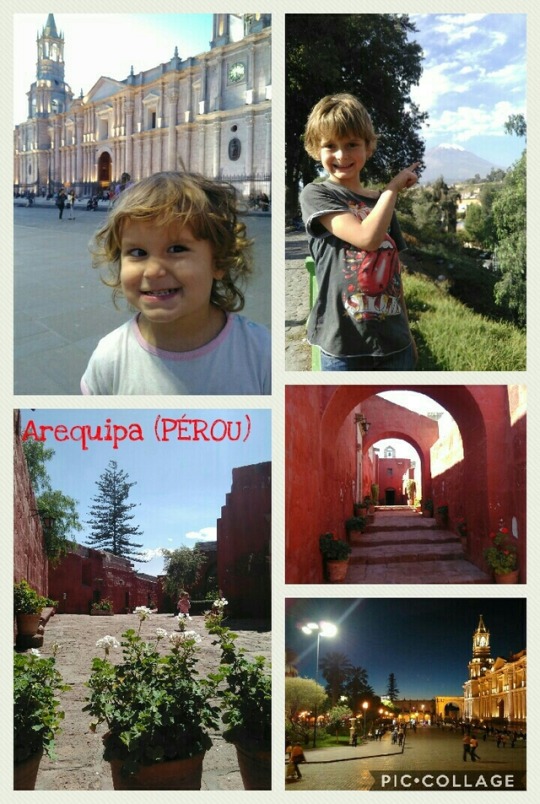
05.05.2017 au 09.05.2017 Arequipa (PÉROU)
Très belle ville, Arequipa fut un sacré coup de coeur!
Nous y avons visité le musée Santuarios Andinos où nous avons eu la chance de rencontrer Juanita la Blanche Neige andine, pauvre petite princesse des glaces qui fut offerte à l’Apu, dieu du volcan Ampato.
Nous avons appris de nombreuses choses sur les incas, peuple qui nous impressionnera à chacune des différentes découvertes. Ils maîtrisaient avec succès la trépanation, utilisaient leur propre cordon ombilical pour se soigner (chaque maman en avait la garde), (étaient-ils au courant de la présence dans le cordon des cellules souches et de leur importance??), escaladaient des montagnes jusqu’à 6300m d’altitude avec des chaussures en peau de Lama et l’aide de quelques feuilles de coca pour faire des offrandes à leurs dieux, construisaient des bâtiments en granite, sans “ciment” et où les pierres s'emboîtent parfaitement les unes dans les autres (leurs techniques de construction dépassent largement les techniques espagnoles de l’époque, les bâtiments incas résistant bien mieux aux nombreux tremblements de terre que subit le pays.)
Autre belle découverte: le couvent Santa Catalina! Du 5étoiles!!!
Notes
Juanita, princesse des glaces... (http://www.trek-cordillere.com/perou-colca/juanita.html). C’est au musée Santuarios Andinos que l’on admire la célèbre momie Juanita, émouvante princesse des glaces.

Celle-ci fut découverte le 8 septembre 1995 dans la calotte glaciaire du Nevado Ampato, à 6 380 mètres d’altitude, par le guide aréquipénien Miguel Zarate et l’archéologue américain Johan Reinhard, pour une mission financée en grande partie par le National Geographic Magazine. Suite à l’éruption du volcan Sabancaya, les glaces de l’Ampato se mirent à fondre sous l’effet de la chaleur. Les deux explorateurs vont alors extraire la célèbre momie, dont la conservation était presque parfaite, en raison des très grands froids qui sévissent à ces altitudes.
Le cadavre de la fillette était recouvert de fines étoffes incaïques. Ses tissus et liquides organiques étant pratiquement intacts, les bactéries et les virus qu’ils contenaient permirent de livrer des indications sur l’état sanitaire des populations indiennes de l’époque et le contenu de son estomac donna un aperçu de l’alimentation d’alors. À ses côtés, ils retrouvèrent également un petit sac rempli de feuilles de coca et plusieurs types d’offrandes : vases à chicha (bière de maïs), lamas en argent, figurines couvertes de tissu.
RECIT SUR LE VOLCAN AMPATO :
Les premiers alpinistes ?
Les occidentaux sont avides de premières. Le premier à fouler le sommet du Mont Blanc. Le premier à gravir un 6000 m. Le premier à réaliser l’ascension de tous les sommets dépassant 8000 m.
Tant d’orgueil à toujours vouloir écrire l’histoire. Et si d’autres que nous avaient déjà visité ces hauts lieux ? La question est élucidée le 8 septembre 1995, au sommet de l’Ampato, volcan de 6310 m au Sud du Pérou, à 80 km au Nord d’Aréquipa. Ce jour-là, 2 archéologues, Johan Reinhard et Miguel Zárate arpentent les flancs du volcan à la recherche de vestiges incas. Un ancien sentier inca visible sur l’arête ouest se perd à l’approche du glacier.
Tout donne à penser que cette montagne fut le lieu de cérémonies pour demander de l’eau et de bonnes récoltes au volcan ou pour apaiser sa fureur.
Or depuis quelques mois, le Sacanbaya, volcan de 6000 m est entré en éruption crachant un épais nuage de cendres sur son proche voisin l’Ampato. Cette cendre grise a tôt fait de recouvrir son glacier favorisant ainsi l’absorption du rayonnement solaire et accélérant brutalement la fonte de la glace. C’est le moment d’aller explorer la montagne !
Arrivés au bord du cratère, non loin du sommet, Johan voit son compagnon, devant lui, entailler de son piolet la glace avec insistance. Il vient de découvrir un objet rougeâtre qui a la forme d’un petit éventail de plumes.
Ils comprennent qu’il s’agit là d’une coiffe, comme l’on en trouve d’ordinaire sur les statuettes incas servant aux cérémonies.
Une, puis deux autres figurines apparaissent à leur tour, décorées d’or et d’argent. Dispersées le long d’un couloir raide, des pierres plates, reliques d’une ancienne plateforme située en amont, ont été entrainées vers le bas par la fonte de la glace.
Près de l’une d’elles apparaît un étrange ballot de chiffon que Miguel prend d’abord pour un sac abandonné par un grimpeur. Très vite, ils comprennent que ce doit être une momie. Tout autour, éparpillés sur la glace, des objets divers, des pièces de tissu, une figurine féminine, des os de lama, des tessons de poteries, des feuilles de coca, deux sacs en tissu contenant des graines et un épi de maïs.
Dégageant au piolet le paquet d’étoffes, ils peuvent voir enfin le visage, celui d’une fillette de 12 ou 14 ans environ. Sacrifiée rituellement au sommet de l’Ampato, la fillette fut recouverte par les voiles de neige successifs, jusqu’à ce que, la fonte exceptionnelle aidant, la glace la restitue cinq siècles plus tard un peu en dessous de l’endroit d’origine.
Venue peut-être de la capitale de l’Empire, Cuzco, ou d’un village alentour, elle est montée le long de ce chemin escarpé qui escalade le flanc ouest du volcan, sans doute accompagnée d’une partie du village, des prêtres, de musiciens, des hommes conduisant les lamas avec sur leurs dos les offrandes et le matériel nécessaire à une ascension de plusieurs jours. Le premier campement a été installé au pied du cône, à 4950 m où sont encore visibles des murettes et des poteries incas. Le lendemain, une douzaine de personnes sont restées avec elle, l’accompagnant sur ce long chemin qui suit l’arête sur 1000 m de hauteur.
Une plateforme à 6100 m sur le glacier a servi de campement supérieur : de nombreuses touffes d’herbe utilisées comme tapis isolant sur la neige, des piquets en bois, de la corde et des lambeaux de couverture de laine ont été retrouvés -certainement des restes de tentes-, avec de la poterie pour préparer la nourriture. Sans doute les lamas sont-ils montés jusque là, car ils ont laissé des traces de leur passage, avec les porteurs et quelques personnes, parmi lesquelles peut-être des membres de sa famille. Après une nuit à plus de 6000 m d’altitude, seuls les prêtres et la jeune fille sont montés vers le sommet. Sans doute affaiblie par la montée, une nuit passée à haute altitude dans le froid, peut-être anesthésiée par un breuvage fort ou une drogue, elle aura sombré rapidement dans un profond sommeil. Après la cérémonie, la fillette morte, ils se sont affairés à la préparer au mieux pour son ultime voyage, l’installant au centre de sa tombe en position fœtale, comme c’était la coutume, disposant autour d’elle ses objets familiers et recouvrant sa petite niche de pierres plates pour mieux la protéger.
A l’heure où les Occidentaux découvraient le Mont Aiguille, les Incas crapahutaient sur les glaciers à plus de 6000 m pour vénérer les montagnes comme des divinités pourvoyeuses d’eau et de fertilité, et leur faire offrandes et sacrifices. Nombreux sont les vestiges de cérémonies retrouvés sur les hauts sommets andins comme le cerro El Plomo au Chili, le Llicancabur ou le Sajama en Bolivie, le Salcantay au Pérou. Alpinistes avant l’heure, les Incas montaient là-haut pour rencontrer leurs Dieux. Les vrais explorateurs de la Cordillère des Andes ne sont pas les Occidentaux mais bien les Quechuas et les Aymaras, descendants des Incas et gardiens des traditions et des croyances liés à ces sommets.
D’après National Geographic, juin 1996, “Peru’s ice maidens” par J. Reinhard et Cordillères andines par Bernard Francou et Patrick Wagnon
Le couvent Santa Catalina, un monastère hors norme!!


Le couvent de Santa Catalina a été fondé en 1580 par une riche veuve, Maria de Guzman et s’étend sur 20.000 km2. Durant quatre siècles, 170 nonnes (des carmélites) et leurs servantes y vécurent coupées du monde, comme des reines! Véritable ville dans la ville, le couvent est une citadelle murée avec ses ruelles, ses passages, ses perrons et ses petites places. Ce sont surtout les couleurs bleu, rouge et orange qui attirent l’œil.
Le monastère accueillait les novices en échange du versement d’une dot importante, en pesos d’or ou bien en mobilier, tableaux, bijoux et pièces d’orfèvrerie Au temps de sa splendeur, début 18e s., cet enclos chatoyant abritait plus de 500 personnes, pour moitié des religieuses, pour l’autre des servantes et esclaves (noires), la congrégation comptait aussi des petites orphelines ou des filles abandonnées, des femmes battues cherchant refuge, etc. Le nom des nonnes les plus illustres - la plupart issues de l'aristocratie de la ville, telles Ana de Los Angeles Monteagudo, María Murtado, Rosa Cardenas, Dolorès Llamosas, etc, demeure gravé à l'entrée des cellules, on devrait dire des "suites" car les recluses pouvaient conserver leur train de vie et disposer d’un véritable petit appartement, incluant parfois salon meublé et décoré, chambre principale et chambre de service pour leur servante, cuisine et jardinet….
2 notes
·
View notes
Text
7 top things to do in Arequipa in Peru
7 top things to do in Arequipa in Peru
We had an amazing time in Arequipa. After traveling 2 months in South America and desolate places this quite Western and colonial city was such a relief. Known as the white city and one of the prettiest in Peru, Arequipa should definitely be on your list when visiting Peru. It is also the starting point for visiting the Colca canyon. There is a lot to do in this vivid city. In this blog post we listed our top things to do.
Go to: Introduction | Background and facts | Plaza de Armas | Monasterio de Santa Catalina | Museo Santuarios Andinos | Churches | Mundo Alpaca | Mercado San Camilo | Cozy cafes and restaurants
Some background and facts
There are two different stories about the origin of the city. The first story is that the name was given by the people called Aymara and that the name Arequipa means ´behind the mountain´ The mountain we are talking about is Vulcan Misti. Another story goes that the leader of Incas, Mayta Capac was that charmed by the valley that he yelled: Ari, quipay! Translated, it means: ‘Yes, we stay here!
“What’s in a name, the origin of Arequipa: Ari, quipay (Yes, we stay here!)”
Click To Tweet
The city is surrounded by volcanoes and suffered a lot from earthquakes. The last heavy earthquake was in 2001. Because of these earthquakes, the city is dominated by low buildings. But the buildings are definitely worth a look. Colonial buildings made out of ashlar (squared building stones) decorate the streets. It feels very Western and we thought we accidentally were teleported to a Spanish city like Barcelona.
The town is the birth place of Mario Vargas Lloza, who won the Nobel Prize Literature in 2010. There is a library named after him that is worth a visit. As you can see already, it’s a charming place with a lot of history.
Go to: Introduction | Background and facts | Plaza de Armas | Monasterio de Santa Catalina | Museo Santuarios Andinos | Churches | Mundo Alpaca | Mercado San Camilo | Cozy cafes and restaurants
7 top things to do in Arequipa
1. Plaza de Armas
Considered as one of the prettiest plazas in entire Peru. It is the most important public place in Arequipa and you can notice that by the buzzing atmosphere on this square. In the middle of the plaza de Armas, there is a small park with a fountain in the middle. On the fountain, you can find the statue of Tuturutu, an important symbol of the city. Around the plaza, you can find some important buildings, with impressive portals and balconies. La Catedral is also a major attraction here. The cathedral itself is impressive both from the inside and outside.
The fountain on the Plaza de Armas of Arequipa with on the background La Catedral
Fun fact: the first organ ever shipped to South America is inside this cathedral. The interesting fact though is that it’s 100% Belgian export. Something to be proud of as a Belgian tourist.
To summarize, wandering around this square, enjoying the sun and observing the locals is a top thing to do here.
Cost: Nada, it’s free to wander around and observe the locals.
The Belgian (!) organ in La Catedral in Arequipa.
Go to: Introduction | Background and facts | Plaza de Armas | Monasterio de Santa Catalina | Museo Santuarios Andinos | Churches | Mundo Alpaca | Mercado San Camilo | Cozy cafes and restaurants
2. Monasterio de Santa Catalina
One of the most fascinating religious buildings in Arequipa. And a very photogenic place as well.
Originally from 1579, this monastery is built in Mudejar style (like the Alhambra in Granada, Spain) with brightly colored walls. The monastery has a rich history. In the beginning, the cloister accepted only women from the Spanish upper class society to become a nun in the monastery. From the cells, you can still see that the nuns living in the monastery were very healthy as they brought a lot of expensive things with them. However, in 1871, the Pope send a more strict nun to the monastery and all the rich ladies were send back to Europe.
The total surface of the monastery is rather large, so take plenty of time to visit it. Wander around through the colorful little streets, enjoy the vibrant colors of the flowers that decorate the monastery and get an insight on how the nuns lived here.
Cost: It is rather expensive, 40 soles per person. But according to us, it’s definitely worth it.
Beautiful red and blue colors in the monasterio Santa Catalina
The little streets make this monastery a very special place
Go to: Introduction | Background and facts | Plaza de Armas | Monasterio de Santa Catalina | Museo Santuarios Andinos | Churches | Mundo Alpaca | Mercado San Camilo | Cozy cafes and restaurants
3. Museo Santuarios Andinos
This museum is dedicated to one person, a 12-15 year old Inca girl, Juanita, whose body was discovered at Mount Ampato. She was offered to the Inca gods somewhere between 1450 and 1480. Because the body was frozen, the mummy is really well-preserved and has been subject to different scientific researches. Since 1996, her body is at the museum.
Besides the mummy herself, the museum displays different objects that were found together with Juanita. Beautiful clothes, ancient bowls, figurines made of wood, silver, gold, … There is also a 20 minutes film about the discovery of ‘the Ice Maiden’, as Juanita is sometimes called.
Cost: The entrance fee to the museum is 15 soles. A guide is obligatory but free, although a tip is expected at the end. The tour takes about one hour.
Go to: Introduction | Background and facts | Plaza de Armas | Monasterio de Santa Catalina | Museo Santuarios Andinos | Churches | Mundo Alpaca | Mercado San Camilo | Cozy cafes and restaurants
4. Churches, a lot of beautiful churches
You can find a lot of churches in Arequipa. The most impressive one is the cathedral at the main square. It is unique in Peru, as it is the only cathedral that stretches the length of a plaza. A lot of the cathedral is rebuild since 1868, as it suffered a lot from earthquakes and fires. The inside is airy and simple.
Cost: Seeing the cathedral from the outside is free, entrance fee for the inside is 10 soles.
La Catedral in Arequipa is beautifully lighted in the evening
Other churches that are worth a visit are Iglesia de la Compania de Jesus, which is said to have the most beautiful interior of all churches in Arequipa. Beautiful carvings, paintings and statues.
Lots of details on the outside of Iglesia La Compana in Arequipa
The Iglesia San Augustin is a perfect example of Baroque mestizo style and has a beautiful high altar, plated with gold. On our download page, you can find a walking tour that takes you to the most important churches of Arequipa.
Go to: Introduction | Background and facts | Plaza de Armas | Monasterio de Santa Catalina | Museo Santuarios Andinos | Churches | Mundo Alpaca | Mercado San Camilo | Cozy cafes and restaurants
5. Making new friends at mundo Alpaca
Right in the center of the city you can discover a whole new world, Alpaca world! It sounds like a cool theme park and actually you can have a pretty good time here. This place has been designed to let tourists discover and interact with alpacas. It is only a 10 minute walk from the main square (Plaza de Armas). It offers:
Beautiful colonial architecture with grass areas
An interactive and educational experience with alpacas
Demonstrations of weaving and traditional fabric sorting
We had a great time here, and best of all it’s totally free. You can feel kind of obliged to buy something in the gift shop, but they are not pushy.
Mommy and baby alpaca at Mundo Alpace
Go to: Introduction | Background and facts | Plaza de Armas | Monasterio de Santa Catalina | Museo Santuarios Andinos | Churches | Mundo Alpaca | Mercado San Camilo | Cozy cafes and restaurants
6. Experience authentic Peruvian life at Mercado San Camilo
When visiting Arequipa, this market can’t be missed. Although the city has a lot of big supermarkets, the local people still prefer to buy their food on this market. It’s a place where you can wander around for hours. An entire row full of ladies selling the best smoothies you ever had, with exotic fruits you haven´t seen before. Another row of butchers that are selling literally every part of the animal, and little stands with herbs and cheeses. Or find your perfect authentic souvenir on this market, with colorful table cloths, stuffed alpacas or a typical Peruvian hat.
Tickle your taste buds with some authentic Peruvian food like a Salchipapa or get your daily dose of vitamins with one of the delightful smoothies. And don´t forget your camera, as this place is very photogenic and bursting with color.
Cost: It´s for free to wander around, but we advise you to buy something to eat. It’s so cheap and delicious!
A top view on the ladies that prepare delicious smoothies on the market San Camilo
Towers of fruit make this market a colorful spectacle
Butchers at the market, selling some stuff we never had seen before!
Go to: Introduction | Background and facts | Plaza de Armas | Monasterio de Santa Catalina | Museo Santuarios Andinos | Churches | Mundo Alpaca | Mercado San Camilo | Cozy cafes and restaurants
7. Cozy cafes and restaurants with delightful food
One of the things we missed a lot in Asia were cafes or restaurant that are intimate and cozy. But in South America, and especially in Arequipa, they know how to make a room atmospheric and cozy. Walking through the streets you can find one café after the other, all inviting you to enter and order a cocktail or a Pisco Sour. Not to mention the many rooftop bars with a magnificent view over the city and the backdrop of volcano Misti!
But Arequipa is also a place for foodies, withe some amazing restaurants, delicious food and educative workshops. We will write a blog post about top places in Arequipa for foodies soon.
A cozy street in Arequipa full of cafes and little restaurants
Have you been to Arequipa? Let us know what you liked or disliked about it in the comments below. As always if you have any questions or remarks we are here to help!
Thanks for reading, Matthias & Mieke
Go to: Introduction | Background and facts | Plaza de Armas | Monasterio de Santa Catalina | Museo Santuarios Andinos | Churches | Mundo Alpaca | Mercado San Camilo | Cozy cafes and restaurants
Why not pin it for later?
The post 7 top things to do in Arequipa in Peru appeared first on Pack to Life • Travel & Photography Blog.
from WordPress http://ift.tt/2wG91mx via IFTTT
0 notes
Text
One Day, One Place: Arequipa, Peru
While Lima may claim the lion’s share of restaurants on World’s Best lists, feisty Arequipa more than holds its own as a culinary — and a cultural — hotspot. Founded by conquistadors in 1540, it owes much of its spicy flavor to Spanish influence, deeply rooted in everything from the architecture to the adobo (though Arequipeños would argue that their version of the long-simmering pork stew is uniquely their own). Adding to its tourist cachet: A Unesco World Heritage city center, a 500-year-old frozen mummy, an abundance of high-quality alpaca (wearable and edible), cobbled pedestrian streets lined with sidewalk cafes, and lively bars serving fresh-fruit pisco cocktails. The bustling marketplace offers everything from breads, pastries, and stalls overflowing with passion fruit, papaya, and citrus (juices squeezed to order), to lunch counters serving local specialties such as pig’s ear, lamb’s head, and cuy (guinea pig). Head upstairs to sample queso helada, which literally translates as cheese ice cream, but is actually a delectable frozen milk confection flavored with cinnamon and coconut. The postcard-perfect Spanish colonial town square is framed on three sides by arcaded balconies and elaborately carved baroque buildings made of shimmering white volcanic sillar. Grab a seat on a bench near the fountain or stroll the flower gardens and soak up the cacophony of local gossip, street vendors hawking lucuma ice cream (a Peruvian fruit that tastes like butterscotch), and Andean pan-flute ensembles playing endless refrains of El Condor Pasa. For a small donation, the guard will give you a tour of the basilica, the small museum of religious artifacts and papal mementos (Arequipa is estimated to be 90 percent Catholic, the most of any Peruvian city), and the two bell towers where you can take in splendid views of El Misti, the city’s iconic volcano. The signature dish of lamb, beef and alpaca cooked on a volcanic slab comes with a variety of dipping sauces and sides of potatoes or quinoa. The five-acre maze of cloistered walkways, gardens, and galleries is painted in vibrant hues of red and cobalt blue, a striking contrast to the stark life that existed here for centuries. Stop for tea and a slice of the famed orange or passion fruit cake at the serene courtyard cafe before heading out to visit Juanita, the 500-year-old frozen Incan maiden who was discovered in 1995 near the summit of the Ampato volcano. The combo museum/factory outlet features live alpacas and llamas, weaving demonstrations, and a store selling premium-quality alpaca clothing at very decent prices. Try the chupe, a soup of river shrimp, potatoes, and fava beans; the pork adobo; or a traditional causa, a cold mashed-potato napoleon layered with tuna, egg, shrimp and avocado. from Travel News and Features http://www.sfgate.com/travel/article/One-Day-One-Place-Arequipa-Peru-10984797.php
0 notes
Text
0 notes